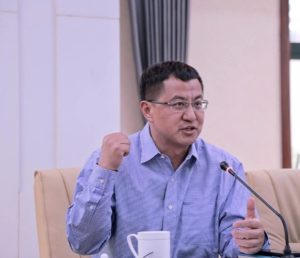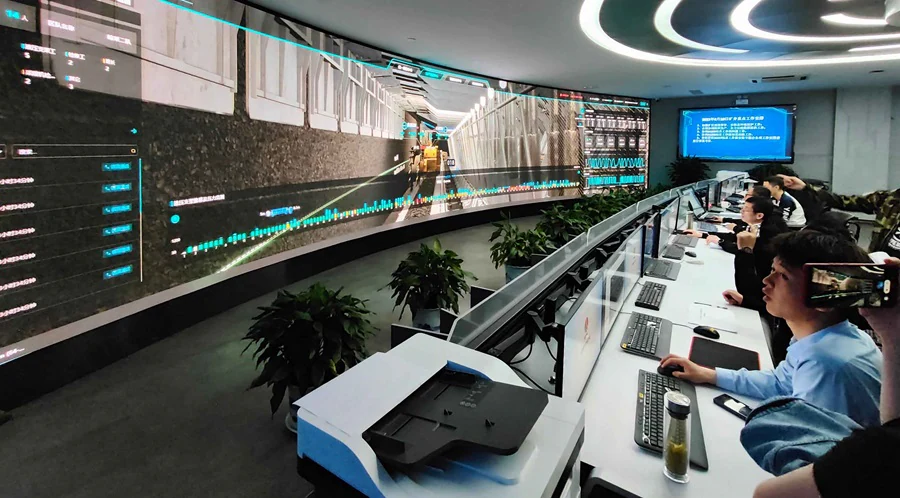Following the launch of its groundbreaking AI-based Pangu Mining Model in July 2023, Paul Moore caught up with Jun Xu, CTO of Huawei’s Mining BU, to find out how this large model will help mines to achieve new levels of operational control and intelligence. A recent video highlighting some of the use cases can be viewed below.
China has 2.8 million coal miners working in 4,400 coal mines. The total annual yield reaches 4.56 billion tons. With such high capacity, and a low automation and intelligence level, working conditions of the millions of coal miners are harsh. Huawei’s Pangu models dive deep into the mining industry and make mines more intelligent, so that more miners can operate above ground. Piloting in Shandong Energy Group’s mines, Huawei, Shandong Energy Group, and Yunding Technology have already jointly explored six innovative intelligent services and eight application scenarios.
Jun Xu, CTO of Huawei’s Mining BU, recently caught up with IM on its Pangu Mining Model

The intelligent industrial production platform based on AI large models addresses the difficulty of applying AI in the mining industry. It facilitates the wide adoption of AI solutions and intelligence upgrade in the mining industry. The models’ two-level architecture decouples operation management and intelligent production, which boosts management and production efficiency. The central cloud focuses on operation management, data sharing, AI development, training, and unified model management. The edge cloud carries AI inference and applies the results to intelligent production.
Here Jun Xu explains what the Pangu Mine Model is, how large models function in mining and what the future holds.
PM: Huawei is already well known in mining – what is different about you latest innovations based on AI?
JX: While we have been a leading player in information and communications technology (ICT), such as LTE 45 and 5G networks in mining for some time, we took another step by setting up a dedicated AI services focused mining team about three years ago. Initially some of the major mining players – both on the equipment OEM side and on the mining company side, had some doubts – but after three years of working on our ecosystem, they now really see the value that Huawei can bring to the table as an enabler. It has become clear how we can leverage our technologies and expertise on the digital side to help mining make some big advances. Mining can be quite conservative so a fresh pair of eyes – looking at problems from a different angle – is really beneficial to help operators think a bit differently and address some of the challenges that have been there for a long time but not addressed. As stated, for many years in the enterprise market with ICT, we really are already leaders in networks, connectivity, clouds, computing and data storage. These are vertically agnostic types of solutions that have similar applicability in many industries. What we wanted to do was take this technology and apply it to a specific vertical like mining, which is far from easy.
PM: You have recently launched the Pangu AI Model 3.0 in July, more specifically the Pangu Mining Model. Can you summarise what exactly the model is?
JX: Simply put, the Pangu Mining Model is an AI-based model that is pre-trained using the Pangu large model developed by Huawei in the last few years. It can be quickly adapted to meet scenario-specific needs and address complex challenges in multiple industries. Working with customers, in this case our first customer, the coal mining major Shandong Energy Group, it combines the primary model with the mining data accumulated by them over a number of years. So we can train the Pangu model to be specific to Shandong Energy Group. It is a vertical, mining specific model – which makes it very different to generic pre-trained large models – such as language models like ChatGPT and LlaMa AI. The mining model that we launched is really a combination between our Pangu 3.0 model and real mining industry specific data.
PM: What does the Pangu Mining Model do in a functionality sense?
JX: Large language models are well known to most people through ChatGPT, which itself is starting to be used by some mining operators. In the next few years, industries like minin are is likely to replace small models with large AI-based models. Not just for language – it will include ERP-related tasks, facial recognition and autonomous driving. The large model will serve as a central brain of the mining operation and it will carry out all of the AI-related tasks. The model solves problems caused by fragmented scenarios, and transforms the workshop-scale coal mine AI model development to factory-scale development. The Pangu Mining Model offers a set of automated tools to users, so that they no longer need to manually design and develop those from scratch. Instead, the model automatically generates scenario-specific models after being fed with relevant data, which greatly simplifies the development.
PM: What makes it so applicable to the mining environment? Can you give some use cases?
JX: Mining is very different to other industries. It involves a harsh and dirty environment and underground mining in particular is seeing and will see many, many uses cases for AI. Especially this is the case with remotely and autonomously operated mines – where you are trying to remove people from the more dangerous active mining areas, taking them from below ground to above ground. This will bring both productivity and safety benefits. It will also make many tasks previously seen as challenging, much easier. As an example, with its visual recognition capabilities, the Pangu Mining Model is already working with Shandong Energy Group at their Lilou coal mine intelligently analysing the quality of stress relief drilling, and assisting rock burst prevention personnel in quality verification. The solution reduces manual review workload by 82%, and delivers 100% acceptance rate for rock burst prevention engineering work. At the same mine, by accessing to a high-speed camera near tail ropes, the AI inference server analyses the camera signals in real time to detect whether there is an anomaly. When a tail rope is found in abnormal conditions such as loose strands, broken strands, and swinging beyond the limit, an alarm is generated and sent to the maintenance personnel for on-site maintenance, which eliminates possible hazards and protects people and material property during the lifting process. Others include monitoring of the proper wearing of PPE, monitoring of personnel riding overhead passenger devices, monitoring of personnel entering dangerous areas accidentally, and monitoring of key posts, AI supervision and analysis of people needed per shift, monitoring of substation patrol inspection compliance, intelligent control of abnormal coal reload and shipment, and AI monitoring of conveyor links.
PM: The Pangu Mining Model has a layered system – can you explain what this means?
JX: It has a three-layer model architecture with different capabilities at different layers. L0 consists of five foundation models, which are NLP model, CV model, multi-modal model, prediction model, and scientific computing model. They provide multiple skills to meet requirements in industry scenarios. L1 contains many (N) industry-specific models. They can be general industry models trained on public industry data. Or, users can train their dedicated models with their own data based on L0 models and L1 general industry models. L2 contains scenario-specific models, which are focused on specific mining application scenarios or mine specific services. Users can enjoy out-of-the-box model services.
PM: What was the fundamental need for the Pangu Mining Model in the mining sector? How does it differ from a traditional machine learning model?
JX: Mining has been working with AI to a limited extent already. Now, with a transformer-based approach, we can consolidate many of the small models that have been developed in recent years. Technically we are now talking about a transformer-based algorithm as opposed to previous systems that have relied on ANN/CNN/RNN deep learning neural networks. And it has proven itself more capable. From an operational point of view, today you have companies developing huge numbers of smaller models that they have to develop, deploy and manage. Huawei’s Pangu Mining Model can consolidate everything that has come before. It also means it is much easier for the mining customer to test and evaluate the model in advance of deployment. We are bringing them an enterprise grade set of tools; and with the individual customer we can fine tune those tools to specific use cases.
PM: Your initial partner for Pangu Mining Model is Shandong Energy Group – can you talk about how you have since worked collaboratively with them?
JX: Shandong Energy Group is a very well known company in China – they are a large owner and operater of coal mines as well as operating power generation sites. We began discussions with them more than two years ago, and they were very receptive to more use of AI from the outset, despite having zero internal knowledge or expertise with regard to AI-based models. There is a perception that Chinese state-owned enterprises (SOEs) are quite backward and slow to innovate. But often this is not the case – and Shandong Energy are very organised, very innovative and very open to new ideas. They were willing to take the leap and see the potential benefits. We have built a close partnership approach with them.In January 2022, Shandong Energy, Yunding Technology, and Huawei established a joint innovation center where we have built an AI training facility based on Huawei’s Pangu models. The AI operation system, which features central training, edge inference, cloud-edge coordination, learning by using, and continuous optimisation, and the AI management system characterised by group management and coal mine execution, transforms manual and passive coal mine production management to intelligent and active management. We have many Huawei expert engineers working there with the Shandong developers and engineering team. And that side by side approach means we at Huawei have really learnt a lot about mining as well.
PM: What are the synergies between the ICT part of the Huawei business in mining and this new AI and transformer based large model side?
JX: I am originally a network specialist and have been working in the networking and connectvity sector for industry for many years. I would say networks are the foundation of these digital solutions. Without a good network in place, everything else is impossible. Our expertise in 5G, fibre optics and router switches forms a platform on which we can run our AI, cloud and video solutions. Also we know a lot of the mining groups, not just in China but also globally, well because of our network offerings. This gives us an edge when we come to work with them on something industry specific, like our Pangu Mining Model.
PM: So where do you go from here with Pangu Mining Model in terms of expansion and evolution?
JX: I would say there are two aspects to our plans. First, we will continue to evolve the solution with Shandong Energy Group into a suite of truly multi-modality solutions, including language. But compared to the consumer side of AI-based models like ChatGPT, which focuses mostly on extensive neural network processing, in mining, this will not be enough. It needs to achieve multi-modality to fully take advantage of the large model. Beyond Shandong Energy Group we are already applying the Pangu Mining Model to autonomous driving in some of the large open pit mines in China and you will be hearing more about that. Finally, as a global company, we also want to bring the large model capabilities to mining customers outside of China; we are just fine tuning the model in China first where we have the most resources within Huawei.











